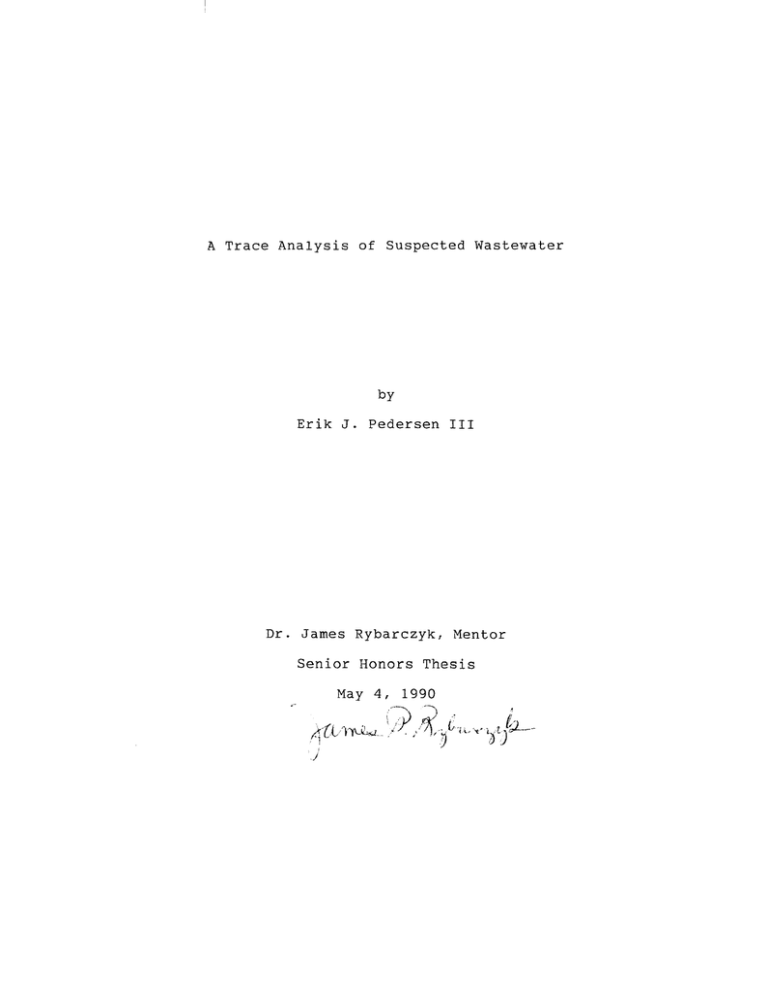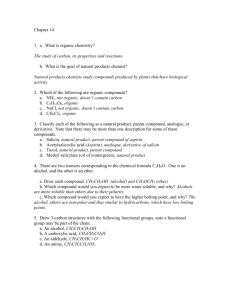A Trace Analysis of Suspected ... by Erik J. Pedersen III
advertisement

A Trace Analysis of Suspected Wastewater
by
Erik J. Pedersen III
Dr. James Rybarczyk, Mentor
Senior Honors Thesis
May 4, 1990
/.----,
-),
t1tVnd~. \/;:,'1.,,/;TV'<' lotI~"-"-,J
A Trace Analysis of Suspected Wastewater
INTRODUCTION AND THEORY:
This project involved the testing of water for organic
pollutants. The water being tested was under a great deal of
suspicion; it was a creek (Mud Creek) which passed directly
through a landfill. Mud Creek, which converges with the White
River, is part of the Muncie water supply. The landfill, located
just outside of Muncie, was thought (by local residents) to
be using careless dumping techniques. In addition to this,
people who had wells in the area complained of being sick more
than usual. Past research (1) had also shown conclusively that
the landfill contaminated the creek with several toxic inorganic
trace metals. There seemed to be ample reason to conduct an
analysis of organic pollutants.
The most effective method of testing for organic compounds
in a liquid sample was gas chromatography. Gas chromatography
is a qualitative (tells what it is) and quantitative (tells
how much) technique which can detect compounds as low as
1~10
mg/L. Gas chromatography is a fairly simple technique. The
liquid is injected with a syringe into a port, where it is
picked up by an inert carrier gas. This gas flows continuously
through the column. Inside the column are solid particles,
known as the stationary phase, which interact with the compound.
The column is heated to a temperature which will put the compound(s)
into a gaseous state. The carrier gas and compound, known as
the mobile phase, flow through the column at a constant rate.
When differE!nt compounds are present, they interact with the
stationary phase differently.
Some compounds are very reactive
2
(with the stationary phase) while others are not. In this way,
the different components of a mixture can be separated. Compounds
which are less reactive with the packing will come out of the
column earlier than more reactive compounds. The time required
for a substance to completely go through the column is known
as the retention time.
(see diagram I)
The detE!ctor used with this column is a thermal conductivity
detector. This apparatus basically consists of a heated metal
wire, which carries a current. This current then passes through
a series of resistors, known as a Wheatstone Bridge. The carrier
gas alone gives a constant current while passing over the wire.
Organic compounds do not conduct electricity as well as the
carrier gas, and the change in current is picked up by the
resistors as the compound passes over the wire. The detector
is hooked up to a strip chart recorder, which prints out the
changes as peaks. Each peak corresponds to a single compound.
(see diagram II)
3
Diagram I: GOW Mac 150 Gas Chromatograph
._----,",
,-
;
,
} I~
'
",
'~
C~0S/j Spcho~\
of CJlclWl,1\
~-.~~­
e"r''('1' IAq
gas
( HeLJMl
\
'--
CO \.,10'\11
-'-.
;,
~
\
":..
- "'c....... _,
4
Diagram II: Schematic view of Detector
Gu':>
~..,
\GO'")
0\.11'
-!)t;rec.. ~0r
8aHery
----
rI' f\ /'1 r----./\ I \ / \i\/,J\/1/'1 /"--'1 i \
--
.... -----~
\.-
-------.
5
EXPER IMENT Al~:
Water samples were taken from several sites. These samples
were taken both upstream and downstream from the landfill.
The difference, assuming there was one, would be due to the
landfill. Two ditches, which drained from the landfill (west
and east of it) were also examined. The samples were sealed
and refrigerated immediately after collection, to prevent volatile
organics from evaporating.
The experimental procedure was very straightforward. The
seemingly polluted samples (such as Mud Creek downstream) were
the main focus of investigation. Each sample was run "as collected"
(not concentrated). However, only one peak was registered by
the detector in each case. This peak, of course, was water.
Any other compounds should have shown up as separate peaks.
This procedure was repeated many times. Several different variables
were incorporated into the procedure. For example, the samples
were shaken before analysis (in case the organics were more
dense than the water, and were near the bottom). The samples
were also taken from different places in the creek, and at
different water levels. The results of these tests were the
same; only one compound (water) was seen.
The next technique used was extraction. A small amount
of organic solvent (5ml, compared to 50ml of water) was used
to solvate any organic compound present. The rationale behind
this was that if the compound would go into solution, it would
be at a relatively higher concentration than in the water.
Several extractions were taken each time, and then combined.
A variety of solvents were used, including polar and nonpolar,
6
as well as volatile and nonvolatile. Polar molecules contain
an electronegative or positive element(s), such as oxygen (0),
and react differently than nonpolar organics. It should also
be noted here that the gas chromatograph contains two columns:
one which rE!acts with polar and one that reacts with nonpolar
compounds. In each stage of the testing, both columns were
used. The two nonpolar (and poorly volatile) solvents used
were toluene and xylene. The two polar, volatile solvents used
were dichloromethane and ether (universal organic solvents;
almost everything is soluble in them). The result of each test
run, however, was the same: one peak, one compound.
Two additional techniques were then employed. The flow
rate was varied, as was the temperature. Different flow rates
make compounds come out at different times, and can increase
or decrease resolution. This proved futile, as no additional
peaks "appeared." The temperature variation also gave negative
results. It was hoped that increasing the column temperature
might vaporize a nonvolatile organic which previously could
not be seen. It did not, however, and lowering the temperature
(to see a volatile compound) gave a similarly negative effect.
Finally, combinations of all of the previously listed
techniques were tried. Nonvolatile extractions were run at
high column temperatures, for example (and vice versa). One
other technique used in the search for organics (specifically
nonvolatile) was the "boiling off" of water. More specifically,
water was distilled away, in hopes that the less volatile compound
would remain behind. As more of the water was boiled off, the
amount of organic compound left behind would supposedly become
7
greater. The small amount of remaining water could then be
extracted with a solvent, and run through the G.C. This method
was very time consuming, and gave no positive results.
8
RESULTS:
(1) There were no detectable, significant amounts of organic
pollutants in the water immediately surrounding the landfill.
(2) These results were confirmed by a mass spectrometer analysis
performed on a Mud Creek (downstream) sample.
Actually, very
minute amounts of naphthalene (a component of diesel fuel)
were found.
It's concentration, however, was so low (5-10
ppb, after condensing) that it could not have been detected
by the G.C. used.
Mass spectrometers are extremely expensive,
and I did not have access to one.
9
DISCUSSION:
The results of this experiment, although not very exciting,
were definitely positive. Muncie's drinking water was (and
hopefully is) not being contaminated by organic compounds from
the landfill. The experience was rewarding, though it did not
initially seem to be. A good working knowledge of the gas chromatograph
was obtained, and many techniques were learned. All possibilities
for finding compounds were seemingly exhausted. A great deal
of time was spent on this "search" for contaminants, and none
were found. The confirmation by mass spectrometer analysis
was an assurance that a thorough job had been done. The knowledge
and experience obtained in this research is extremely valuable.
These techniques could be applied to trace analysis of almost
anything (especially organic compounds), or mixtures of different
compounds (as would be utilized by food and drug analysis).
The research done in this lab was both functional and educational.
10
REFERENCE:
Bye, Sheryl.
"The Migration of Heavy Metals from
a Landfill to Surface Waters"
(unpublished).




